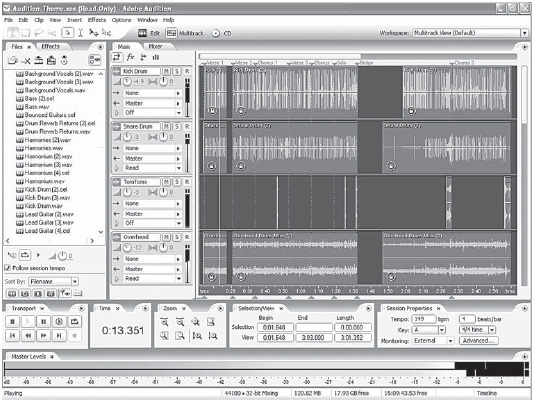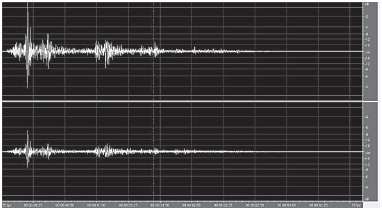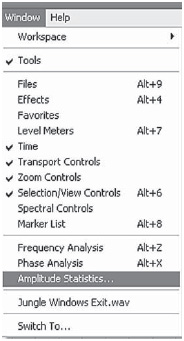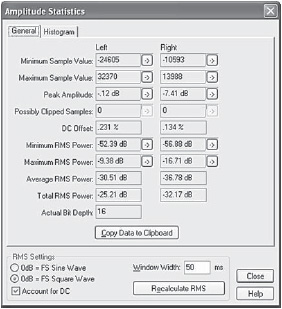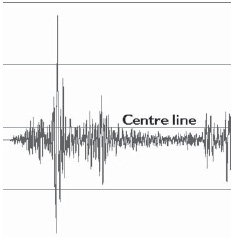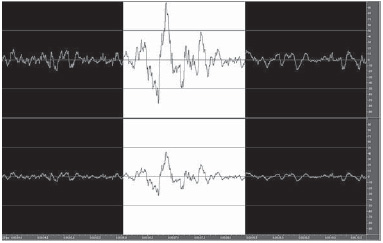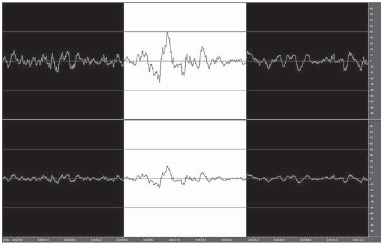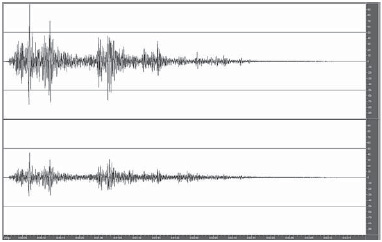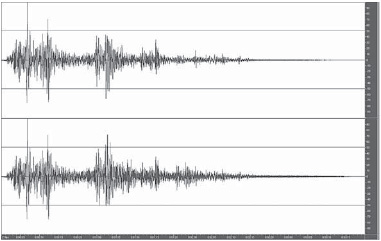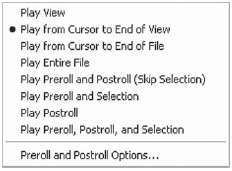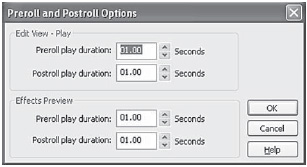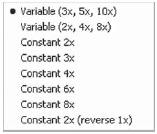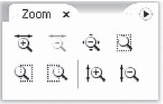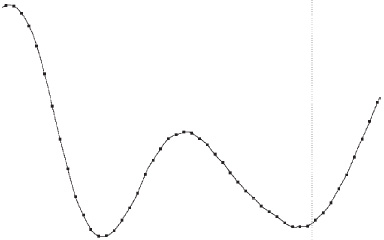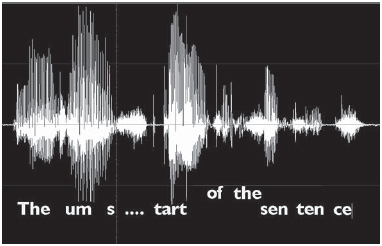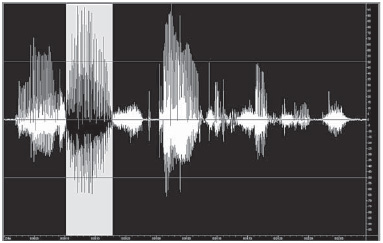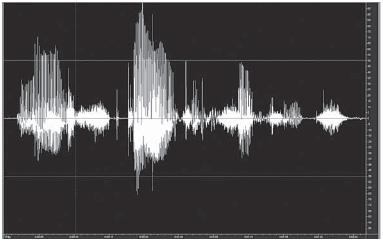4
Editing
4.1 Introduction
Adobe Audition 2.0 is two editors in one, linear and non-linear plus a CD Burner (Figure 4.1). They are toggled between by clicking the appropriate icon at the top of the screen just below the menu.
Figure 4.1 Adobe Audition 2.0 Edit, multitrack and CD Burner icons
We'll look first at the linear editor which physically changes the audio files so that data is changed when the files are saved.
When you first run Adobe Audition 2.0, it will open ‘Audition-Theme.ses’ in the multitrack editor (Figure 4.2).
Figure 4.2 Audition-Theme.ses
Apparently this is because, in earlier versions, some customers had not noticed the multitrack editor was there!
If you click ‘Edit’ in the workspace panel at the top you will see a blank centre screen surrounded by a large number of icons, as shown in Figure 4.3. This should not be a cause for panic! The icons at the top can be ignored until you are familiar enough with the editor to find them useful. The most important controls are the transport and zoom icons at the bottom. We will come to them as soon as we have loaded a file.
Figure 4.3 Entering Adobe Audition 2.0
4.2 Loading a file
OK, maybe you have not recorded anything yet, but you will find that your computer already has a number of wave files. They have the file extension WAV (if you have set Windows to show extensions). Click Fileopen… and you get the file selector.
To show Windows file extensions: Open a desktop window (e.g. Disk C) and click tools/folder options. This will open a tabbed panel. Select the View tab and untick the ‘hide extensions for known file types’ box.
You will find a lot of them in your C:WINDOWSMEDIA directory. These are the sounds that Windows can make when it is asked to undertake various actions. You may have turned some, or all, of these off, but the wave files are still there. Indeed you may decide that your first exercise with the audio editor is to make some new sounds to personalize your computer. With Windows XP loading JUNGLE WINDOWS EXIT.WAV gives the illustrated display (Figure 4.4). This is a clap of thunder. (It is possible that it was not copied to your hard disk when it was installed. This depends on what sound scheme options were selected. It is part of the Jungle Sound scheme.)
Figure 4.4 Display when JUNGLE WINDOWS EXIT.WAV is loaded
Figure 4.5 shows the status line at the bottom of the screen revealing that the recording uses 324k of disk space, is 3 seconds and 59 frames long, stereo, at 22 050 samples per second (Audition's display in the illustration is set to the CD standard of 75 frames per second. Don't confuse this with the European TV structure which has 25 frames per second).
Figure 4.5 Status line
This particular recording looks as if it is low level but, in fact, it is only 0.12 dB short of full modulation. How do I know this? Because I can get Audition to tell me!
Selecting Window/Amplitude Statistics (Figure 4.6) will give a dialog similar to Figure 4.7. This gives statistics for the left and right channels of the file. Clicking on the arrows will take you to the point, such as Minimum sample value, described. Halfway down the box are the entries for DC Offset. This should be very low – almost zero. Click the ‘Account for DC’ box and then ‘Recalculate RMS’. You should now get the second table showing the peak amplitude of the left channel as being –0.12 dB.
Figure 4.6 Thunder peak selected
Figure 4.7 Selecting Window/Amplitude Statistics gives the Amplitude Statistics dialog
The Normalize option – Effects/Amplitude/Normalize (Figure 4.8) – allows you to set the normalization level, choose whether to apply DC Bias correction and, for stereo files, choose whether you want left and right channels separately normalized or to keep the level change the same for both (this preserves sound images positions in the sound stage).
Figure 4.8 The normalize option
Close examination of some waveforms can reveal that they have what is called a DC offset. I have simulated a 10 per cent offset in Figure 4.9. If you look at the detail, you can see that the whole waveform is offset slightly below the centre line. Offsets like this are highly undesirable as they will produce a click every time the track is started or stopped and can cause clicks on edits.
Figure 4.9 DC offset
A good quality sound card should not introduce an offset, but a lot of cheaper ones do. This is not a disaster, as the offset can be removed by the editor. There is an offset on the thunder file supplied with Windows.
In Adobe Audition 2.0 this can be corrected as part of the normalization process when the level is corrected to produce full level. It used to have an option to remove DC on-the-fly during recording. This had the disadvantage that if you left this switched on ‘just in case’ it prevented you from doing bit-for-bit digital clones via Audition as it acts as a low frequency filter.
If you actually want a DC offset you can change the value from 0 per cent to the value you require. This may seem an unlikely need but could be useful to correct an offset manually.
The Decibels format option sets the values entered into the ‘Normalize to’ box to show decibels rather than percentages. It's conventional to set the level to –0.5dB rather than 0dB as, if two samples are either side of a peak the Digital to Analog converter may produce an instantaneous level higher than 0 dB causing distortion in apparatus downstream of the converter.
The reason the audio looks so low level is that there is a brief moment at the start of the thunder where the level virtually reaches the peak. By zooming in on the detail we can see that it is literally one cycle of audio from negative to positive. As the stereo sound is not coming from the centre, the right-hand channel (bottom display) is even lower in level (Figure 4.10).
Short peaks are a common problem with level adjustment. It is one of the prime skills of mastering engineers in the record industry to modify these so that the resulting CD can be made louder.
In this case, we can make a louder file by highlighting the section, reducing it by 6 dB and then renormalizing. We can also, if we wish, untick the Normalize L/R Equally box, to bring up the right-hand channel. Using the Edit/Zero crossings options can ensure that our selection does not stop, or start, in the middle of a cycle, which can introduce a click (Figures 4.10-4.13).
Figure 4.10 Thunder peak selected
Figure 4.11 Thunder peak reduced by 6 dB
Figure 4.12 Thunder, renormalized with ‘normalize L/R equally’ set
By doing this manipulation we achieve a louder recording, although the peak level remains the same. However, we have brought up the background noise as well, which may or may not be a good idea. You may like to try this, if you have this file on your hard disk. The process has now revealed two more peaks that are holding down the level. When do you stop? That's where skilled ears come in. A similar process is gone through when music is mastered for CD. Removing a few peaks can make a commercial disc sound louder. This has become rather competitive as no company wants its discs to sound quieter than their rivals.
While a full level recording is ideal for production use, this may not always be the case for the version heard by the end user. Windows sound effects are a case in point; it is generally desirable to set these 6-12 dB below maximum recording level. This allows the PC speakers to be set at a good level for when they are reproducing music from a CD, or even your editing session, without the Windows sound effects blasting you out of the chair!
Figure 4.13 Thunder, renormalized with ‘normalize L/R equally’ not set
4.3 Transport
To modify recordings, we need to be able to navigate round a sound file. Adobe Audition 2.0 presents the whole of the file when loaded. Personally, I find this reassuring and have never got on with other editors that only show the beginning of a loaded file.
Figure 4.14 Transport icons
The keys to navigation are the transport and zoom icons at the bottom left of the screen (Figures 4.14-4.17).
The left-hand block is for the transport and is reassuringly like a cassette recorder, with a few extra options. Stop, Play and Pause are followed by the triangular play icon in a circle – a second play button!
Clicking the standard play triangle symbol plays the file, as you would expect. The triangle in a circle play button will also start the playback but, optionally, in a different way.
The spacebar will “press” the last play button you used which, as they can be given different start and stop points, is useful or confusing options depending on your point of view. The next icon – an arrow pointing to its own tail – sets up a loop mode so that playback never ends but loops round, either to the start of the file, or to the start of the selection. In fact, right clicking on the play buttons gives you a number of options (Figure 4.15) most of which are self-explanatory.
Figure 4.15 Playback options
Figure 4.16 Zoom icons
Figure 4.17 Preroll and Postroll options
Play View: play the visible part of the file from beginning to end.
Play from Cursor to End of View
Play from Cursor to End of File
Play Entire File: wherever cursor is the playback starts at the beginning of the file and plays through to the end.
Play Preroll and Postroll (Skip Selection): This rehearses an edit by playing from one side of a selection to the other skipping the selection.
Play Preroll and Selection: play from just before selection of end of selection.
Play Postroll: play from end of selection for a few seconds.
Play Preroll, Postroll and Selection: Do not be confused by the word order the playback is from just before the start of the selection to just after the end of the selection.
The double arrow buttons ‘spool’ the cursor along the file (audibly if in the play mode). Figure 4.18 shows the options revealed by right clicking the buttons. The other spool buttons take you to the beginning or end of the file, or to the next marker if you are using them. The final button, with the ‘red LED’, is the record button.
Figure 4.18 Options
The playback ‘head’ is represented by a vertical line. This can be moved to where you want, merely by single clicking the point with the mouse. If you are already playing the file then a cursor line will appear where you clicked but playback will not be interrupted. Clicking a play triangle will instantly move the playback to the newly selected point. The space bar toggles playback mode on and off. If you are using this, then it toggles through stop, before going to the new location on the next press.
You can select an area by dragging the mouse over the area you want. The alternative is to click one end, with the left mouse button, and then click the other end with the right mouse button. The selected area can be modified with right mouse clicks. The selected edge nearest to the mouse click is the one modified. By default, Adobe Audition 2.0 requires you to press control to change the selection with a right click, otherwise it gives you a popup menu. This can be reversed by clicking the Extend Selection option within the Edit View Right clicks section in the General Tab of the Edit/preferences dialog. This reversed operation was how the original Cool Edit worked and is, in my view, preferable.
You can also select the edit area ‘on-the-fly’ as you play the file. There are two keyboard shortcuts called ‘Selection anchor left when playing’ and ‘Selection anchor right when playing’. ‘Out of the box’, Cool Edit sets these to the ‘[’ and ‘]’ keys. This means that if you press th'e ‘[’ key while you are playing a file the start of the selection will be set to the point playing at that moment. At the same time, the point where Cool Edit starts playing from when play is pressed is moved there as well. Pressing the ‘]’ key marks the end of the selection. Stop, then by pressing ‘Delete’ you will delete that selection. Pressing the spacebar will restart play from your edit. You can then either ‘spool’ back or use a preroll option and check from before your edit. The spool controls are not allocated a keyboard shortcut by default but can be (see Section 16.3 on Keyboard shortcuts in Chapter 16 ‘Tweaks’). Being able to use the keyboard, rather than the mouse, can vastly improve efficiency of a session where a great deal of edits are made. This is more typical of a speech editing session than a music one. This could transform the use of the program for blind users who can now edit by ear rather than being frustrated by the visual nature of PC audio editing, but, unfortunately Audition breaks some existing conventions.
Zooming
The Zoom panel has eight icons controlling how the audio is seen (Figure 4.19):
Figure 4.19 Zoom Panel
From left to right on the top row:
• + zoom in horizontally
• – zoom out horizontally
• Zoom out full both axes
• Zoom to selection.
From left to right on the bottom row:
• Zoom in to left edge of selection
• Zoom in to right edge of selection
• Zoom in vertically
• Zoom out vertically.
It is very easy, quickly to examine a section of audio. Click on the point you are interested in. Define a selected area by dragging or using the right mouse button and click on the ‘Zoom to selection’ icon. You can repeat this as many times as you like to get into really fine detail. You can even set the magnification to be so large that you can see the individual samples (Figure 4.20).
These are represented as dots. They are joined by a line generated by the computer. This line is not simply dot-to-dot for cosmetic reasons, but will show what will happen to the audio after the output filter.
If necessary you can move the dots, literally to redraw the waveform. This can sometimes be the only way to eliminate a very recalcitrant click that has slipped through declicking software.
Figure 4.20 Waveform zoomed-in to show samples
In Figure 4.21, I have drawn a five sample click this way, to illustrate that the line joining the dots is more intelligent than it first appears; the wavy lines show what is known by audio engineers as ‘ringing’.
Figure 4.21 Five sample square pulse drawn onto waveform showing computer's interpretation of the result
4.4 Making an edit
Editing on a PC is best done visually. Some editors (including Audition 2.0) have a ‘scrub’ editing facility where the sound can be rocked backwards and forwards as on a reel-to-reel tape machine. People used to quarter inch tape ask for this, probably out of fear, or sentiment. In practice, nearly everybody edits visually. The technique is very simple and the eye and the ear work together easily. It is much easier to learn, from scratch, than is scrub editing. Very soon you will be able to read the waveform. For example, you may know a particular point is overlapped three times. It is often possible to spot the individual retaken sections and select the last one without listening to the intervening audio. If, on performing the edit, you find that you are wrong then UNDO quickly restores the cut. By making ‘bets’ like this you can considerably speed up the editing process, particularly with scripted speech editing.
Editing audio is surprisingly similar to editing text in a word processor. If you use a word processor, then you already know the basics of editing audio. You use your mouse to select a start and finish point. The space between is highlighted by reversing the colors. Pressing DELETE removes the highlighted section. Alternatively clicking Edit/Trim (or Control/T) will eliminate everything except the selected area (ideal for ‘topping and tailing’).
As already described, the selected section can be created in many ways. The most obvious is to place the mouse at the start of the section you wish to cut and drag the pointer to the end of the cut section. Audition also allows you to select the other end of the selection from the cursor by right clicking on the point (while pressing control unless you have reversed the action of the right click). This works forward or backward.
4.5 Visual editing
This is all very well but how do you find a phrase within an item? Here you use the zoom facility already described.
Figure 4.22 shows a short section of speech ‘The um start of the sentence’. The text has been added to the picture and is not a feature of current audio editors!
Figure 4.22 A short section of speech
How do we go about removing the ‘um’? Clicking the play button with the mouse (or pressing the space bar) will play the section. A vertical line cursor will traverse the screen showing where the playback is coming from. Your eye can identify the section that corresponds to ‘um’.
With the mouse click at the start of this section. The cursor will move to this point.
Press play again and the playback will start from where you clicked. You can hear if you have selected the right place as, if you have not, there will be something before the ‘urn’, or it will be clipped. Reclicking to correct is very fast.
Now identify, not where the ‘um’ ends, but where the next word starts – the ‘s’ of ‘start’. This time click with the RIGHT mouse button. This sets the end of the section to cut (Figure 4.23).
Figure 4.23 ‘Um’ selected for removal
Hit play again and just the highlighted section will be played. Is the end of the ‘um’ clipped? Can you hear the start of the ‘s’? If not then the edit is probably OK. Within Audition 2.0, pressing shift/R will rehearse the edit by playing before the edit (preroll) and after the edit (Postroll). Please note that it is the key presses that are required not just capital ‘R’.
Now press the delete key. The highlighted section is removed (Figure 4.24).
Figure 4.24 ‘Um’ removed
Click a little before the join and play the edit. Is it OK? If so go on to the next edit.
If it is not, then click UNDO and you will be restored to the previously highlighted set-up.
You can adjust the edges of the selected area by right clicking near them.
At first, you may well have to cycle round several times, but soon you will be getting edits right first time. Remember even redoing the edit three or four times is still likely to be quicker than it used to take with a razor blade.

